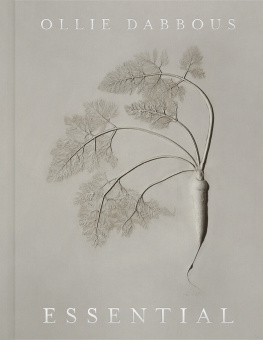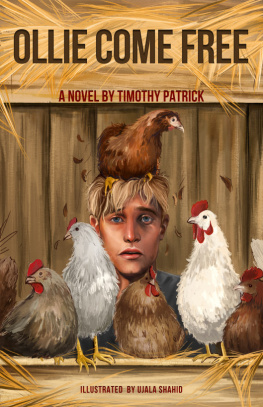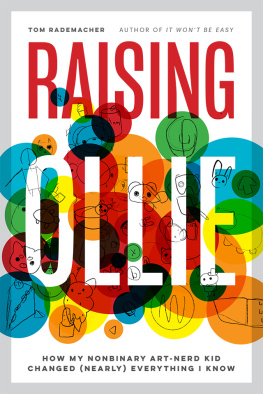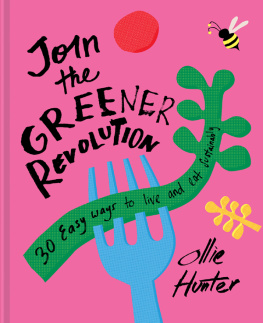BLOOMSBURY PUBLISHING
Bloomsbury Publishing Plc
50 Bedford Square, London, WC1B 3DP, UK
29 Earlsfort Terrace, Dublin 2, Ireland
This electronic edition published in 2021 by Bloomsbury Publishing Plc
BLOOMSBURY, BLOOMSBURY PUBLISHING and the Diana logo are trademarks of Bloomsbury Publishing Plc.
First published in Great Britain in 2021
Text Ollie Dabbous, 2021
Photographs Joakim Blockstrm, 2021
Ollie Dabbous and Joakim Blockstrm have asserted their right under the Copyright, Designs and Patents Act, 1988, to be identified as author and photographer, respectively, of this work.
For legal purposes the constitute an extension of this copyright page.
All rights reserved
You may not copy, distribute, transmit, reproduce or otherwise make available this publication (or any part of it) in any form, or by any means (including without limitation electronic, digital, optical, mechanical, photocopying, printing, recording or otherwise), without the prior written permission of the publisher. Any person who does any unauthorised act in relation to this publication may be liable to criminal prosecution and civil claims for damages.
Bloomsbury Publishing Plc does not have any control over, or responsibility for, any third-party websites referred to or in this book. All internet addresses given in this book were correct at the time of going to press. The author and publisher regret any inconvenience caused if addresses have changed or sites have ceased to exist, but can accept no responsibility for any such changes.
A catalogue record for this book is available from the British Library.
Library of Congress Cataloguing-in-Publication data has been applied for.
ISBN: 978-1-4088-4395-6 (HB)
ISBN: 978-1-4088-4396-3 (eBook)
ISBN: 978-1-5266-4544-9 (ePDF)
Editor: Rowan Yapp
Project Editor: Lucy Bannell
Designer: Dave Brown at APE
Photographer: Joakim Blockstrm
Food Stylist: Ollie Dabbous
Prop Stylist: Jennifer Kay
Indexer: Vanessa Bird
To find out more about our authors and their books please visit www.bloomsbury.com where you will find extracts, author interviews and details of forthcoming events, and to be the first to hear about latest releases and special offers, sign up for our newsletters.


CONTENTS
The best food is always the simplest, whether you are cooking it at home or eating in a restaurant. And the simplest food is always the most sophisticated. With the recipes in this book, I want to capture the essence of each ingredient through what I call boldly refined home cooking: simple techniques, good taste and concise ingredients underpin every dish. The recipes themselves are stripped back to flavour combinations that work together without superfluous fuss and, on the rare occasion that one is slightly more involved, it is always worth the effort; there is a reason why every component is on the plate. Whether its a twist on a classic or a more contemporary dish, these recipes will help you to elevate the everyday into something special. I hope you not only want to eat this food, but want to make it again and again.
All the recipes are accessible to anyone who enjoys good food, even if you have no confidence about how to cook it. So put your trust in me. I hope that you can grow as a cook with this book, as my explanations (often just applied common sense) help you to understand how to cook great food at home and importantly to hone your intuition around ingredients and how to cook them, so you know how to get a recipe just right. I want you to feel proud every time you serve one of these dishes.
Confidence is the greatest asset you can possess in the kitchen; it empowers you to do more with fewer ingredients. And, in fact, the less confidence you have in the kitchen, the less you should over-analyse what you are doing. Instead, taste your food: does it taste right? A good palate only comes with experience. So consciously break things down while you are tasting a dish: does it need more acid? More salt? More fat? Or even as is sometimes the case for dressings a pinch of sugar?
When you make a simple salad, for instance and there are plenty in these pages you need pops of flavour and acidity from citrus or vinegar, the sharpness of a dressing combined with crunchy, verdant leaves. I like to serve a salad at the start of a meal to get you salivating, with flavours that wake up your palate with a jolt. At the other end of the spectrum lies something such as vanilla ice cream, a soft, melting, rounded white cloud that tastes exactly as it looks in a wonderful symbiosis of texture and taste. Its gentle flavours should be like a familial embrace at the end of a meal, rather than anything too demanding or arresting.
My grandmother on my mums side was of the war generation and I cooked with her from the age of six. We always had a proper teatime at her house and I will never forget her egg custard tarts and cakes. As youll see from the recipes in this book, I still like puddings, and it is this comforting nature of home cooking that appeals to me the most. There is something intrinsically soothing about simple food done well. Home cooking has a joy that is quite distinct from the more intricate pleasures of restaurant food. My restaurant dishes have to be exciting, theatrical and sexy, whereas the delight of home cooking often lies in gentle, nuanced and subtle melding of flavours, in slow-cooked braises or soft puddings.
Home cooking is a labour of love, and its a way of showing affection, too. Since becoming a father, Ive felt passionately that eating well at home is something we need to learn to do again as a society. I would love it if we could reintroduce home economics in school, for instance, because if kids learn to cook, they will also learn to respect the process and the produce. Good cooking can be enjoyed by all, irrespective of income: its a true democratic luxury.
It is essential that everyone is able to cook good food at home and to provide a nutritious, delicious meal for themselves and their loved ones. Gathering around the table is both a sign and a symptom of civilisation. A society that eats well is a civilised society with a healthy population, with more mutual respect. When people cook and eat well, they tend to have better relationships and are less likely to hide behind screens, mindlessly absorbing the inane while real life passes them by. The ripple effect of good home cooking is enormous; we ignore it at our peril.
RESTRAINT
The recipes in this book are economical, on purpose. Restraint in the kitchen invariably produces a more sophisticated result, and restraint often comes with confidence. Home cooking shouldnt be clever, just authentic, delicious and honest. Theres something wonderfully inspirational about economy in food. If you are limited in the ingredients you use because you want to cook local produce, or you havent got great reserves of money that forces creativity.
Its the best of cooking; the less you need to do to an ingredient to make a delicious plate of food, the more currency that recipe has. The Italian dish pappa al pomodoro is the perfect example of this: just garlic, olive oil, tomatoes and bread combining to create something incredibly harmonious. Great home cooking is not about using luxury ingredients, its about making nourishing food that everyone can afford. I want the recipes in this book to be both democratic and empowering, for everyone to enjoy; there is nothing elitist or off-putting about them.















